Specific criteria are frequently used to measure the effectiveness of public relations, even though it is not and probably never will be an exact science. In addition to being extremely significant, these PR key performance indicators (KPIs) must align with the brand’s marketing and commercial goals. For example, is the brand aiming to be known for a specific value proposition or offering? If so, every story generated or propelled by PR must have this distinction. Does a company need to push back on stories that have received less-than-ideal coverage to overcome it? In such a scenario, obtaining favourable media placements that appear above any unfavourable search results (and assessing the resulting SEO impact) may be the most crucial objective.
While there is no tried-and-true approach to measuring PR success perfectly, there are proven ways to evaluate various impacts. In this article, I will explain PR KPIs and list the top 10 you need to track that business in 2024.
Key Points
- PR KPIs are quantifiable indicators that help you track and evaluate the performance of your PR campaign against your predefined goals.
- PR KPIs are also an excellent way for your team to understand better what is and isn’t working.
- The “4 Ps of KPI” refer to the four critical aspects of Key Performance Indicators (KPIs) that ensure their effectiveness in measuring and driving performance. These are Product, price, place, and promotion.
- To measure public relations success, here’s what you need to do: Set goals, decide on a marketing strategy, select your PR KPIs, organize and segment your data, and provide targets for public relations KPIs.
What are PR KPIs?

PR KPIs are quantifiable indicators that help you track and evaluate the performance of your PR campaign against your predefined goals. KPIs can vary depending on your PR campaign’s type, scope, and purpose, but they should always be SMART: specific, measurable, achievable, relevant, and time-bound. For example, a KPI for a PR campaign that aims to increase brand awareness could be the number of impressions, reach, or mentions in the media within a certain period.
However, with the need for Public Relations comes the need to measure the impact of this new type of marketing strategy, and traditional methods just aren’t as applicable anymore when comparing Cross-Voice and Cross-Channel methods. Understanding your return on investment and the success of your current marketing tactics compared to your competitors can help determine future budget flow and strategy.
It’s not enough to simply perform PR activities. You must also set PR KPIs that reflect your business goals and track PR performance with reliable public relations metrics. Otherwise, you have no way of knowing if your efforts are working or which efforts aren’t working. Key performance indicators (KPIs) measure unquantifiable goals by making them more tangible. Additionally, they encourage participants to aim for greater heights.
What Are PR KPIs Used For?
Key performance indicators (KPIs) help support a team’s and company’s goals by introducing quantifiable performance measures for a specific PR objective over time.
KPIs are also a great way for your team to better understand what is and isn’t working. They allow you to refine future media campaigns and better optimize your resource allocation, especially when multiple team members are working on PR efforts.
Finally, they are a great opportunity to prove your team’s value to executives and stakeholders through measurable, tangible goals. Explaining you increased your brand’s awareness by a certain percentage is much more impactful than saying you executed two brand awareness campaigns, for example.
What Are the 4 PS of KPI?
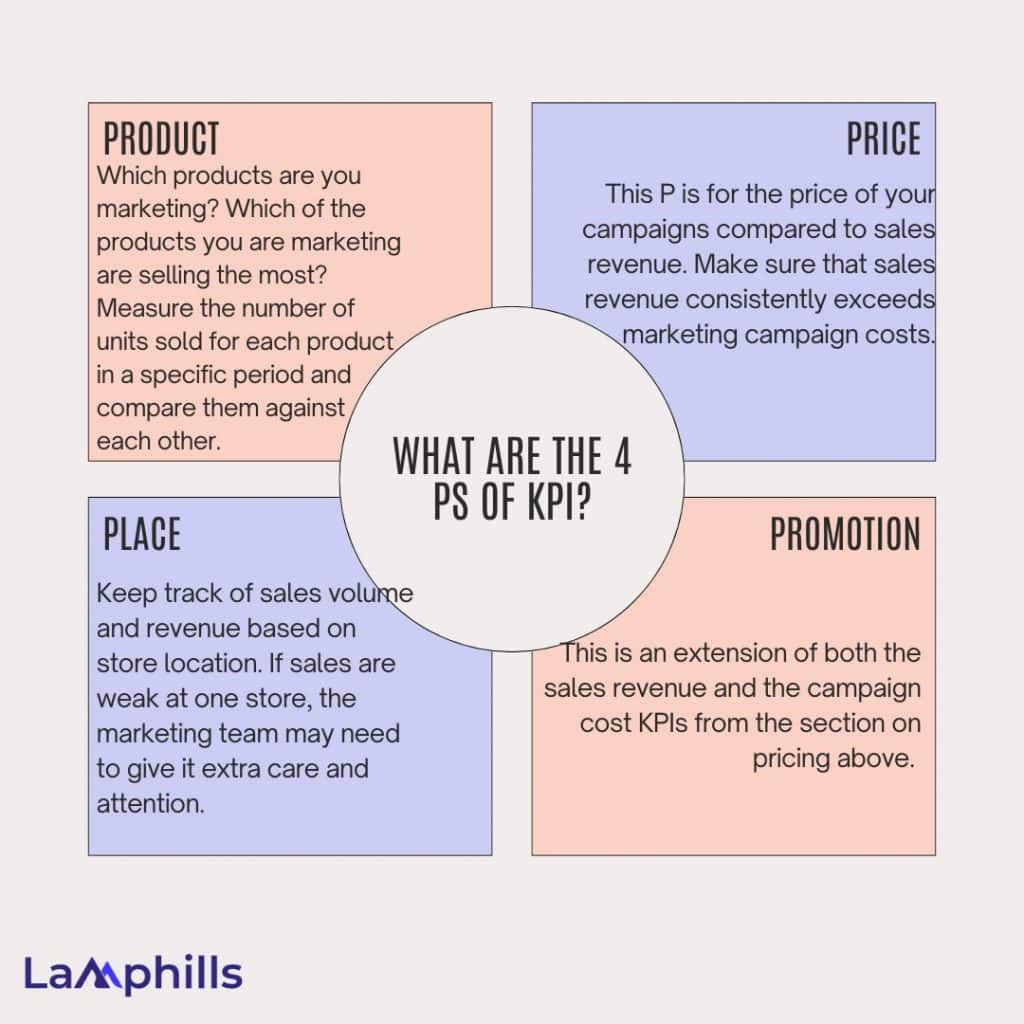
The “4 Ps of KPI” refer to the four critical aspects of Key Performance Indicators (KPIs) that ensure their effectiveness in measuring and driving performance. These are:
#1. Product
KPI: Number of units sold per product
Which products are you marketing? Which of the products you are marketing are selling the most? Measure the number of units sold of each product in a specific time period and compare them against each other. This way you can see which products are performing better than others, which products need more marketing attention, and investigate why some products sell more. Perhaps you are marketing them using different strategies, and one works better than the other. By keeping tabs on the number of units sold, you can also do some A/B testing on certain product attributes. For example, suppose you are experimenting with different colours on product packaging. In that case, you can group the number of units sold based on the color of the packaging and compare them against each other to see which colours sell the best.
#2. Price
KPI: Sales revenue, cost of campaign
This P is for the price of your campaigns compared to sales revenue. Make sure that sales revenue always exceeds marketing campaign costs. In other words, do you have a positive ROI (return on investment)? For example, how many inbound links on your blog posts led to purchases? Or, how did a certain Twitter campaign translate to sales revenue? Another easily quantifiable method is pay-per-click (PPC). If you are using online advertisements to get the word out about a certain product, how does the price of those clicks look against the sales revenue gained? If you find that a certain marketing method isn’t generating enough sales, you should consider focusing your funds and efforts on a different method that optimizes your ROI.
#3. Place
KPI: Number of units sold per location
Keep track of sales volume and revenue based on store location. If sales are weak at one store, the marketing team may need to give it extra care and attention. Perhaps you can place extra promotional ads in their coupon handouts or send your demo crew to give out free samples. Giving consumers a face or two to remember from your company will also help them feel more connected to your brand!
#4. Promotion
KPI: Website traffic, ROI
This is an extension of both the sales revenue and the campaign cost KPIs from the section on pricing above. When running different promotions, which ones are most successful? Which ones gain the most website traffic or generate sales? Which campaign platforms optimize your ROI? If 60% of your traffic comes from Facebook, give that account more attention than your Twitter or Instagram pages. If you run campaigns and promotions throughout the year, which season did you experience the biggest returns? You can gain a lot from measuring ROI from different promotions and analyzing them.
When it comes to measuring KPIs, remember to be specific and measure over a consistent time period. Which specific KPIs you decide to measure always depends on your goal. For more information on KPIs, check out our free KPI Template Toolkit below!
Lamphills KPI Template Toolkit
How Do You Measure PR Performance?
It is difficult to improve if you don’t know whether your marketing efforts are working. However, there are some easy ways to measure public relations success.
Here’s what you need to do:
- Set goals. What is your plan to measure KPIs’ performance? Define your business objectives. Do you want to increase brand awareness or your social media presence? Getting your thoughts down on paper will make achieving your business goals more realistic.
- Decide on a marketing strategy: You must determine whether your marketing strategy is viable by analyzing KPIs.
- Select your PR KPIs: Choose several KPIs to track and report on. Make sure they align with your business goals. This will help you determine whether you’re meeting your objectives.
- Organize and segment your data: Use analytical tools to segment data and make it easier to gauge changes in public relations KPIs.
- Provide targets for public relations KPIs: Pick numbers for the goals you want to hit.
Business executives are being forced to reevaluate how they use key PR performance indicators to lead and manage the company because of the rapid advancement of technology, increased pressure from competitors, and rising customer expectations. Below, I’ve detailed a few PR metrics that will help explore PR’s tangible impact on your brand and website, including measuring public relations’ authority, relevance, and social shares.
PR KPIs for PR Campaigns
Here are the top 10 PR KPIs to track in 2024:
#1. Exposure
Exposure refers to the visibility or attention a brand, product, service or message gets in the public eye. It’s about how much your target audiences see and hear your content.
It’s typically measured by quantitative metrics, such as the number of mentions in the media, social media, websites, events, etc. The more mentions, the higher the exposure.
However, counting the total number of mentions is not enough. You also need to assess the quality and relevance of those mentions to ensure they effectively reach the right audiences.
The number of mentions is high if a company is mentioned in numerous news articles, social media posts, and blog entries. Within those mentions, some may come from reputable sources like major news outlets such as Forbes, The Wall Street Journal, or well-regarded blogs, so the mention quality is high.
The more exposure, the more visible you become.
#2. Media Impressions
Another KPI for PR is media impressions. Put simply, this key indicator represents the number of times your target audience sees or hears your PR message.
Media impressions are a measure of visibility. Remember, in PR, visibility is everything. The more people who see your story, the more impact it has. This is why you should track your impressions.
To monitor media impressions, you need to understand where your target audiences spend their time. Your media coverage analysis reveals that. Then, you can focus on these channels.
How you measure impression may differ depending on whether these channels are traditional or digital.
Digitally, tools like Google Analytics can help you measure your web impressions. If you’re using social media, these platforms usually have in-built analytics tools that reveal your media impressions. Here’s an example from Instagram Audience Insights.
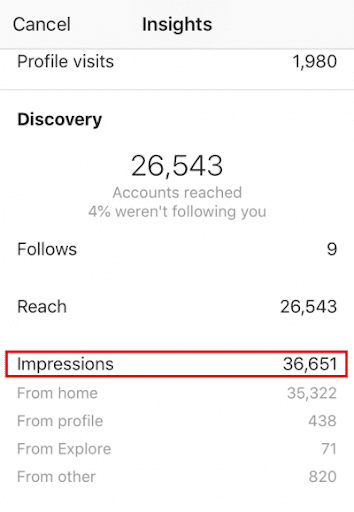
Now, suppose you focus on traditional media for your PR campaigns. In this case, you can:
- Use a research company like Nielsen
- Reach out to ask for broadcast monitoring services
- Or estimate the number of prints in circulations, etc.
- These give you a rough estimate of your impression.
If you’re struggling to increase your media impressions, there’s probably a gap in your strategy. Find and fix it. This could involve reevaluating your media channels or adjusting your messaging to suit your audiences.
Finally, impressions cannot be a standalone metric, especially for social media PR. These focus more on quantity than quality, so if you’ll be tracking your impressions, track engagement as well.
#3. Social Media Engagements
Social media engagement is the level of interaction on social media platforms. It’s the overarching name for metrics like Instagram likes, Twitter retweets, and Facebook social shares.
Generally, a steady increase in engagement levels shows that your target audiences are interested in your brand and are interacting actively.
Some social media platforms don’t make provisions to evaluate total engagement. So, you might have to manually count the likes, shares, and other engagement metrics. Then, record them in a spreadsheet:
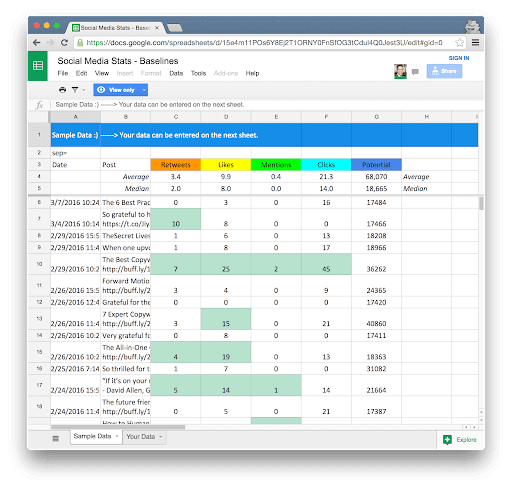
But if you can’t handle this stress, platforms like Plecto have something for you. Plecto integrates with many top social media platforms to automatically visualize your social media metrics, including engagement, and display them on a neat dashboard.
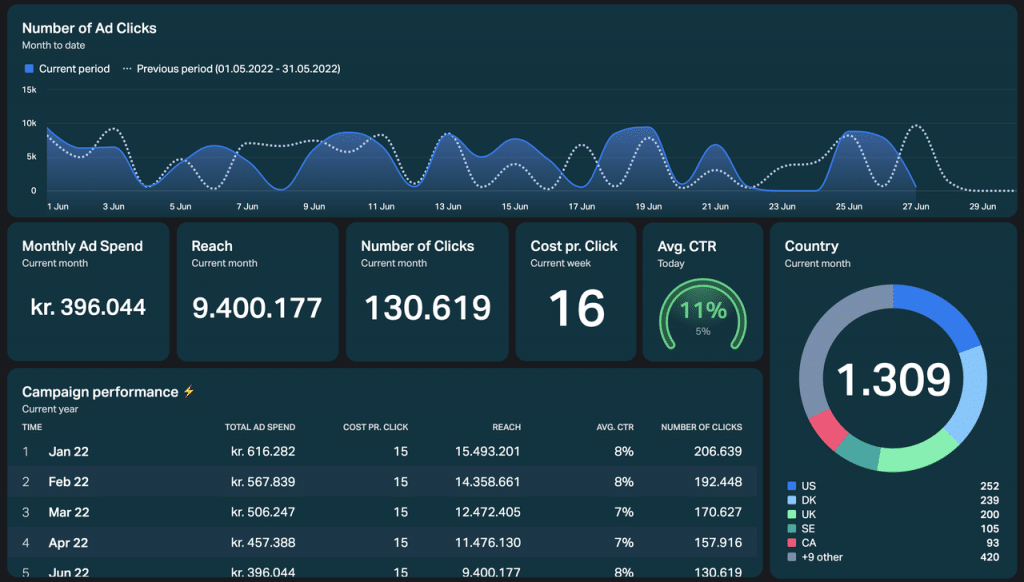
Engagement may vary depending on your number of followers. So, with engagement, there’s no benchmark to assess if you’re doing well. A better way to use this public relations metric is to calculate the engagement rate using the formula below.

When you get your engagement rate, you can then compare it to the industry benchmark in this image:

If you notice a low engagement rate, focus on creating higher-quality content for your campaigns. Around 85% of social media users want to see videos from you so, for instance, you can include more videos in your PR content strategy. Make sure the content is engaging and tailored to your audience.
In addition to content marketing, you can collaborate with influencers, host events, or run contests. These are great ways to better connect with your audiences.
#4. Increased SEO
If a brand needs to boost its search engine optimization, media relations can play a central role in improving that online visibility. Many top-tier media outlets have high-ranking sites, so earning a media placement in them can greatly impact SEO, especially when you work with a dedicated SEO team.
Pros: This measurement tool can be especially useful if a brand has unwanted mentions or negative past coverage it wants to push down.
Cons: Unfortunately, many publications don’t offer backlinks as a matter of journalistic neutrality, and the most effective brand mentions must be linked to show a comparison of individual placements vs. overall traffic and conversions.
Sometimes, a press release sent out on the wire can be a more reliable way to boost a brand’s organic SEO and online presence than a traditional media placement. Also, remember that leveraging PR to boost SEO is most effective with a dedicated and broad optimization effort.
#5. Sentiment
Sentiment analysis, often called opinion mining, evaluates and understands the emotions, opinions, and attitudes expressed in text data – such as social media posts, customer reviews, news articles, or written content.
It’s often expressed as positive, negative, and neutral.
Having lots of mentions doesn’t always mean they’re good. It’s important to check if people are saying positive things about what you’re doing. If they are, you’re doing something right. If it’s not, you might need to adjust things.
#6. Share of Voice
Share of Voice (SoV) measures your share of the total conversations in your industry. It’s one of the PR KPIs that compares your visibility to your competitors’.
Share of voice has many facets. For instance, it can be the amount of traffic you’re getting relative to your competitors. It can also be the amount of traction your hashtag gets compared to the whole industry.
In traditional PR, the share of voice could also refer to your share of radio ads, TV appearances, etc., compared to your competitors.
Using the Plecto KPI tool, you can gain insights into your share of voice. You can then compare your results to those of your competitors to see if you’re up to par.
When analyzing your share of voice, consider the context of the conversation. For instance, suppose most of the conversations around your brand are negative. This will hurt your brand long-term, even with a high share of voice.
If your share of voice is low, here are some experience-based strategies that have worked well:
- Focus on media relations: When you form strong relationships with media outlets and journalists, you’ll increase the likelihood of being mentioned in reports and articles, increasing your SoV.
- Actively engage with the target audience: On social media, be sure to like, comment on, and reply to your audience’s posts. Also, take part in relevant conversations. This helps you establish a positive reputation, ultimately increasing your share of voice.
- Again, content is king. This good old PR mantra still stands today. So, focus more on creating content that will resonate with your target audience.
These three tips increase the likelihood of your brand being mentioned. Thus boosting your SoV.
Read also: What is Share of Voice? A Comprehensive Guide to Measuring Your Brand’s Market Presence
#7. Website Traffic
Tracking the number of visitors who click on your company’s site can be important due to your PR coverage and link placement. This can help you measure the overall reach of your media campaigns.
Examples of how to measure website traffic include:
- Unique visitors
- Unique pageviews
- Bounce rate (i.e. the percentage of visitors who leave after only viewing one page)
- Number of referrals from target media publications (e.g. 134 clicks from the New York Times)
Several tools are available to monitor website traffic. The big one is Google Analytics, which is free. A key to measuring website traffic from earned media is to include custom UTM parameters that link back to your website when someone covers your brand.
#8. Media Monitoring
The process of tracking media mentions is called media monitoring.
Key media to monitor include:
- Online news
- Print news
- Broadcast
- Podcasts
- Newsletters
- Social media
Media monitoring was a tedious task in the past. PR pros combed newspapers and magazines, physically cut out articles, and pasted them into clipbooks.
Today, technology—and tools like Google Alerts and Muck Rack’s earned media software—make media monitoring much easier.
Muck Rack uses the latest advancements in AI and machine learning to source and surface relevant information across channels, including online news, blogs, social media, TV, radio, and more with Muck Rack Alerts.
All you have to do is create an Alert to find new press hits, mentions of any keywords or companies, and more. You’ll receive daily email notifications based on these Alerts.
Plus, Muck Rack provides context. You can see who is writing and sharing stories. Click directly into a journalist’s profile from your Alerts to learn more about them, analyze how the media is talking about the piece, send them a pitch, and more.
While quality rules, quantity can also provide helpful insight. Muck Rack lets you see how many times an article has been shared by journalists on social media, as well as the publication’s unique visitors per month and article sentiment.
#9. Potential Reach
Potential reach is exactly what it sounds like—the number of people seeing your media coverage per month.
It is different from paid and organic reach. Paid reach refers to the number of people who see your content with paid distribution, and organic reach refers to those who see your content without paid distribution (e.g. via Google search or an unpaid Facebook post).
Add the viewership for each publication and website where your coverage is featured to calculate potential reach. For reference, reach is an outlet’s unique visitors per month (UVM), which you can find through an analytics tool, like Google Analytics.
It’s worth noting that potential reach is widely considered a limited data point since it only calculates the quantity—not the quality—of reach.
#10. Regional Exposure
Regional exposure refers to media coverage and visibility in specific geographic areas, states, cities, or countries. PR teams focus on boosting the brand’s presence in these areas.
Monitoring exposure by region involves tracking media mentions by the location of the outlet or journalist. This can also include the share of voice for areas—i.e., the percentage of total coverage coming from each region.
The volume of coverage, potential reach, and engagement levels can also be analyzed by region. This can identify high-interest regions with solid media and audience response. It also helps compare how messaging or stories resonate differently in different markets.
Knowing where your brand is getting attention helps you plan your PR strategies better. It’s like figuring out which neighborhoods you should focus on because that’s where people are most interested in what you’re doing.
How Do You Set KPI for PR?
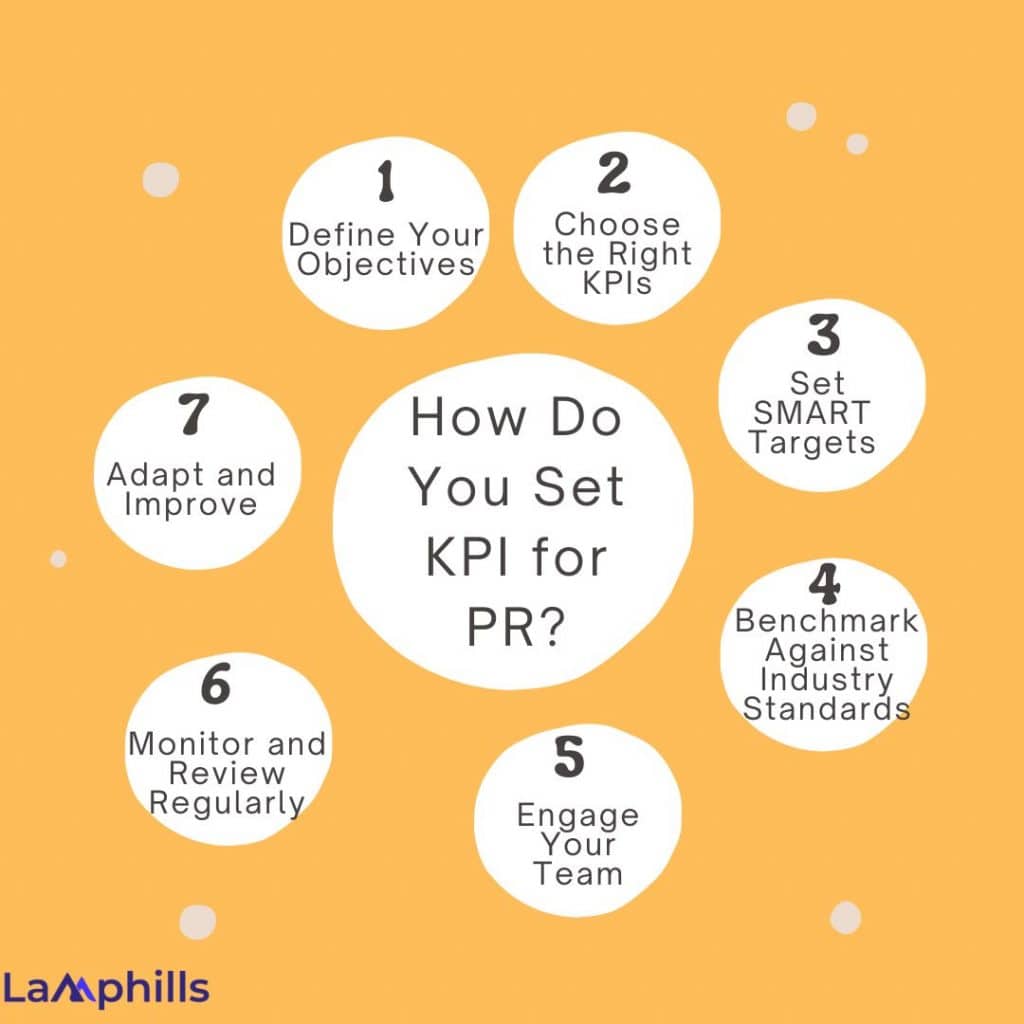
Setting Key Performance Indicators (KPIs) for Public Relations (PR) involves a systematic approach to ensure that your PR activities align with your overall business goals and provide measurable outcomes. Here is a step-by-step guideline that I have provided on how you can set KPIs for PR:
Step 1: Define Your Objectives
Identify your organization’s mission, vision, and strategic goals to clearly understand your business objectives. These will be the foundation for your PR KPI targets, aligning your performance metrics with your overall business strategy.
Step 2: Choose the Right KPIs
Choose relevant, quantifiable, and actionable KPIs. Not all KPIs are created equal–focus on the ones that directly impact your strategic objectives.
Step 3: Set SMART Targets
When setting up KPI targets, apply the SMART criteria to ensure they are specific, measurable, achievable, relevant, and time-bound. This will develop clear, well-defined targets that can be easily tracked and assessed.
Step 4: Benchmark Against Industry Standards
For realistic and achievable KPI targets, research industry benchmarks and compare your targets against the performance of similar organizations. This will give you a better understanding of good performance.
Step 5: Engage Your Team
Collaborate with your team to set targets and encourage open communication about progress, challenges, and successes. This will foster a culture of accountability and drive your team’s commitment to achieving your KPI goals.
Step 6: Monitor and Review Regularly
Regularly monitor your KPI targets to stay on track and make necessary adjustments to your strategy.
Step 7: Adapt and Improve
As you monitor your KPIs, use the insights gained to refine and improve your business processes, continue to drive continuous improvement, and achieve your strategic objectives by adjusting your approach and learning from past performance.
Bottom Line
In conclusion, PR KPIs are necessary to measure the impact and success of your public relations campaign. To take advantage of them, analyze your media coverage and impressions. Also, pay attention to web traffic and social media engagement. All these key indicators keep you in sync with your visibility.
Further, you want to know how you perform compared to your competitors. This is why you should also track your share of voice.
So, don’t just hope for the best – measure your results and make data-driven decisions to improve your PR.
Related Articles
- 15 INTRIGUING PR TRENDS TO WATCH OUT FOR NOW!! (DETAILED INSIGHTS)
- How To Measure Brand Awareness: KPIs To Look Out For
- PR Campaign Secrets: How Top Brands Dominate the Spotlight
- PR MEASUREMENT: Techniques for Tracking What Matters






